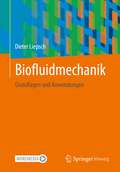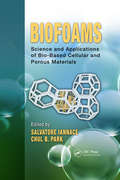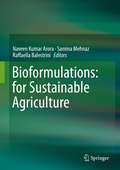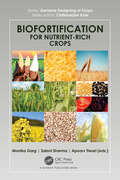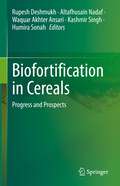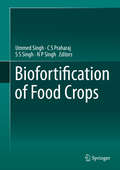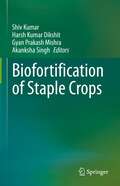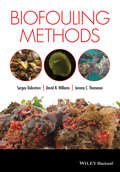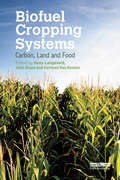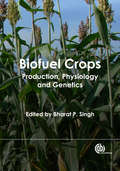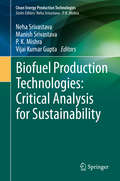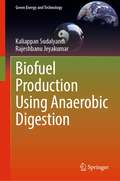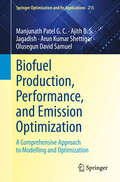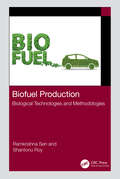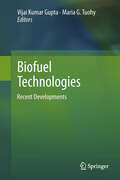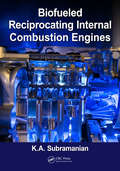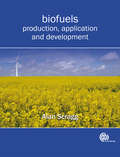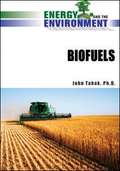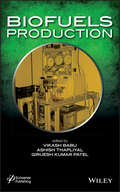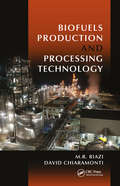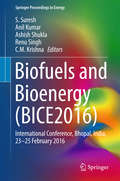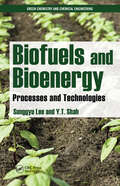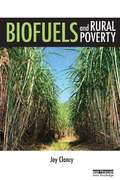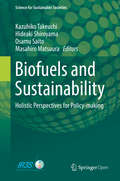- Table View
- List View
Biofluidmechanik: Grundlagen und Anwendungen
by Dieter LiepschDieses Buch führt Sie in die Grundlagen der Biofluidmechanik einWie funktioniert der menschliche Blutkreislauf? Wie arbeiten Mikrozirkulationsvorgänge? Mit diesen und vielen weiteren Fragen der Strömungsuntersuchung beschäftigt sich die Biofluidmechanik. Dieses Buch gewährt ihnen interessante Einblicke in die Grundlagen der Biofluidmechanik.Die Biofluidmechanik ist eine thematisch sehr breit gestaffelte Wissenschaft. Sie erforscht die Gesetzmäßigkeiten der Bewegung, des Kräftegleichgewichtes und der Strömungstechnik von Fluiden. Hierzu gehören unter anderem:• Atmung• Blutkreislauf• Mikrozirkulationsvorgänge• Lymphströmungen• Künstliche Gefäßersatze• Gefäßprothesen aus verschiedenen Materialien• Künstliche Herzklappen• Urologische Messungen• Künstliche Harnleiter• Blutrheologie• Transport durch Membranen• Bewegung geladener Partikel• Ionen in Lösungen• Vibrationen• Wellenfortpflanzung und SchockwellenWichtiges Grundlagenwissen der Biofluidmechanik in einem Buch In seinem Buch gibt der Autor einen ausführlichen Überblick über die Grundlagen der Biofluidmechanik und stellt die folgenden Themen detailliert vor:• Einleitung in die Biofluidmechanik• Physikalische Grundlagen von Fluiden• Rheologische Grundlagen• Biofluide (Körperflüssigkeiten) in Menschen und Tieren• Grundlegende theoretische Fluid- bzw. hämodynamische Betrachtungen• Medizinische Grundlagen, menschliches Kreislaufsystem, Blutgefäße, Herz, Lungenmechanik und Atmung• Besonderheiten und Messmethoden der Biofluidmechanik• Anwendungen und Beispiele in Modellen, diagnostische und therapeutische BedeutungAufgrund des hohen Praxisbezugs ist dieses Buch über die Biofluidmechanik nicht nur für Studenten, sondern auch für Beschäftigte in Gesundheitsforschung und Medizin ein wichtiges und hilfreiches Grundlagenwerk.
Biofoams: Science and Applications of Bio-Based Cellular and Porous Materials
by Salvatore Iannace Chul B. ParkAddresses a Growing Need for the Development of Cellular and Porous Materials in IndustryBuilding blocks used by nature are motivating researchers to create bio-inspired cellular structures that can be used in the development of products for the plastic, food, and biomedical industry. Representing a unified effort by international experts, Biofoams
Bioformulations: for Sustainable Agriculture
by Naveen Kumar Arora Samina Mehnaz Raffaella BalestriniMore than a century has passed since the first bioformulations were introduced to the market. But there is still much to be done, explored and developed. Though bioformulations offer green alternatives and are important for sustainable agriculture, they make up only a small fraction of the total additions used to enhance crop yields or protect them from pests. There is a great need to develop bioformulations that can promote confidence among end users; accordingly, it is imperative that bioformulations to replace chemicals be reliable and overcome the shortcomings of the past. Bioformulations: for Sustainable Agriculture discusses all the issues related to the current limitations and future development of bioformulations. It examines in detail those bioformulations that include biofertilizers and biopesticides (also commonly known as bioinoculants), presenting a global picture of their development. Further chapters address diverse microbes that are already being or could be used as bioformulations. The book also discusses the techniques, tools and other additions required to establish bioformulations as trustworthy and global solutions. It assesses the types of bioformulations currently available on the market, while also considering the future roles of bioformulations, including the reclamation of marginal and polluted soils. Further, it discusses the current legislation and much-needed amendments. Overall the book provides a comprehensive outlook on the status quo of bioformulations and the future approaches needed to improve them and achieve sustainable agriculture and food security without sacrificing the quality of soils. This will be extremely important in offering chemical-free foods and a better future for generations to come.
Biofortification for Nutrient-Rich Crops (Genome Designing of Crops)
by Monika Garg Saloni Sharma Apoorv TiwariBiofortification is a widely accepted cost-effective agricultural strategy to improve the nutrient deficiency in populations. It is especially useful in low income and developing nations. Strategies for biofortification employ crop breeding, targeted genetic alteration, and agronomy, show promise for addressing multiple forms of human malnutrition. To increase the bioavailability of food nutrients, biofortification efforts must focus on improving the nutrient content of food and decreasing anti-nutrients.This book covers the basics of biofortification, international efforts, challenges, opportunities, and the use of the latest omics technologies in addition to classical approaches. It covers the most studied micronutrients, vitamin biofortification, and the new topics in dietary fibers, starch quality, and phenolics. It uniquely covers the antinutrients like phytic acid, ODAP, and Glucosinolates. It also reviews food bioavailability, scientific research, and meta-analyses to assess the health-promoting efficacy of different nutrients. The book attempts to cover all bases, from decision considerations to prospects, as well as biofortification of nutrients, antinutrient reduction, and the use of latest technology to aid in the nutritional enhancement of virtually all recorded food crops.
Biofortification in Cereals: Progress and Prospects
by Altafhusain Nadaf Rupesh Deshmukh Humira Sonah Waquar Akhter Ansari Kashmir SinghThe book addresses recent advances in biofortification using different approaches like foliar fertilizer, plant breeding, and genetic engineering as well as its utilization for improvement of nutritional quality of cereals. The content compiled is contributed by the renowned scientists actively working in the area of the cereal biofortification. This is an authentic, reliable, and exhaustive compilation bringing together the technological advancements, fundamental principles, and applicability of scientific innovations in biofortification. It also discusses policies and regulations for the implication of various strategies. It is useful reading material for researchers and students in the field.
Biofortification of Food Crops
by Ummed Singh C S Praharaj S S Singh N P SinghThe chapters presented in this book 'Biofortification of Food Crops' depict how agricultural technological interventions have true role in alleviating malnutrition. This book highlights the role of multidisciplinary approaches to cope up with the challenges of micronutrient malnutrition or hidden hunger which is an alarming public health issue in most parts of the world including India. In this endeavour, different biofortification approaches such as agronomic (or ferti-fortification), breeding, biotechnological, physiological, microbial etc. has fulfilled their different mandates of nutrient enrichment of food crops including cereals and pulses. The contents of the book proves that biofortified plants have adequate potential to nourish nutrient depleted soils, help increase crop productivity and provide nutritional benefits to plants, humans and livestock. The content and quality of information presented in this book will definitely provide multiple novel ideas of advance techniques and will stimulate innovative thoughts and directions amongst researchers and policy makers in the field of biofortification. In addition, the contributions presented in the book will be a good source of background knowledge and technical know-how to educate the readers about biofortification. The authors hope that the book entitled "Biofortification of Food Crops" would provide a suitable platform in our collective efforts for an appropriate dialogue among the scientists, researchers, entrepreneurs, policy makers and farmers in reducing the budding issues of malnutrition through novel approaches and means.
Biofortification of Staple Crops
by Shiv Kumar Akanksha Singh Harsh Kumar Dikshit Gyan Prakash MishraThis edited book brings together comprehensive information on various aspects of the biofortification of staple crops. It addresses the present status of food and nutritional security and highlights the importance of micronutrients in human health, a historical account of biofortification, current approaches and challenges, crop-specific biofortification efforts and various breeding approaches, including conventional, and genomics enabled improvement. It also explains the efficacy of biofortification, bioavailability, and future thrust. It is an inclusive source of information on different aspects of micronutrients in crops of global importance. Malnutrition is a serious global issue, with millions of people being undernourished, several suffering from micronutrient deficiencies, and the adult population struggling with obesity. Despite significant economic progress, South Asia and Sub-Saharan Africa are still home to an undernourished population. Nutrition-related health problems are related to hidden hunger and are widespread in the developing world. Women and preschool children are more vulnerable. Even though global food production has increased manifolds, estimates indicate that over 60% of the world’s population is deficient in essential micronutrients such as iron, zinc, iodine, and selenium, often causing health problems and developmental delays. Linking agricultural production with human nutrition and health is crucial for ensuring nutrition security. Much research has been carried out to assess genetic diversity related to micro-nutrients in staple crops, their bioavailability, and the efficacy of biofortified germplasm. Biofortified varieties developed in different crops through conventional breeding are being up-scaled for reducing the micronutrient deficiencies in other countries. This book is a ready reference for researchers, academicians, extension personnel, policymakers, students, and value chain stakeholders engaged in agriculture, nutrition, and health sectors promoting nutrition-sensitive diets.
Biofouling Methods
by Sergey Dobretsov David N. Williams Jeremy C. ThomasonBiofouling Methods provides a “cook book” for both established workers and those new to the field. The methods included in this important new book range from tried and tested techniques to those at the cutting edge, encompassing the full diversity of this multidisciplinary field. The book covers methods for microbial and macrofouling, coatings and biocides, and ranges from methods for fundamental studies to methods relevant for industrial applications. There is an emphasis on answering questions and each chapter provides technical methods and problem-solving hints and tips. Bringing together a wealth of international contributions and edited by three internationally known and respected experts in the subject Biofouling Methods is the essential methodology reference in the field for all those working in the antifouling industry including those involved in formulation of antifouling products such as paints and other coatings. Aquatic biologists, ecologists, environmental scientists and lawyers, marine engineers, aquaculture personnel, chemists, and medical researchers will all find much of interest within this book. All universities and research establishments where these subjects are studied and taught should have copies of this important work on their shelves.
Biofuel Cropping Systems: Carbon, Land and Food
by John Dixon J.W.A. Langeveld Herman Van KeulenChoosing appropriate practices and policies for biofuel production requires an understanding of how soils, climate, farm types, infrastructure, markets and social organisation affect the establishment and performance of these crops. The book highlights land use dynamics, cultivation practices related to conversion and wider impacts. It explores how biofuel production chain development is steered by emerging technologies and management practices and how both can be influenced by effective policies designed to encourage sustainable biofuel production. The book highlights major biofuel production chains including: cane cultivation in Brazil corn ethanol in the USA wheat and rapeseed in Europe oil palm in the Far East cane in Asia and Africa SRC and other lignocellulosic crops. In each case the development, cropping systems and impacts are discussed, system dynamics are shown and lessons drawn for the way things could or should change. Biofuel Cropping Systems is a vital resource for all those who want to understand the way biofuels are produced and how they impact other elements of society and especially how improvements can be made. It is a handbook for students, biofuel producers, researchers and policymakers in energy and agriculture.
Biofuel Crops
by Bharat Singh Ratikanta Maiti Pratik Satya J G Isebrands Surinder S Banga Sujata Bhargava T K Biswas S Wani Steven E Mckeand Toshihiko Yamada Ralph Sims Ismail Dweikat Natalie S Betts Caitlin S Byrt L A Moraes S Hemaiswarya C Dana Nelson Belum V Reddy Jagannath Vishnu Patil Holger Schuhmann Somashekhar Punnuri Gary Stephan Banuelos N K Fageria John H Fike C M Williams Martin Weih Robert B Rummer Rachel A Burton Isabel S Carvalho P Srinivasa Rao Eric J Jokela Donald L Rockwood M Czako Ryan P Viator Peer M Schenk Bill Kovarik Leslie H Groom K C Falk A Moreira Kossonou Guillaume Anzoua Eric Obeng Christopher Q Lan Karaj Singh Dhillon R Raja C Ganesh Kumar A V Umakanth Masazumi Kayama David J Parrish Naser Farrokhi Anna Hale Gary F Peter R Ravikumar Serge Bracconnier Hari P Singh P J Minogue Kurt H Johnsen C Eynck L Marton K MuthukumarappanProviding comprehensive coverage on biofuel crop production and the technological, environmental and resource issues associated with a sustainable biofuel industry, this book is ideal for researchers and industry personnel. Beginning with an introduction to biofuels and the challenges they face, the book then includes detailed coverage on crops of current importance or with high future prospects, including sections on algae, sugar crops and grass, oil and forestry species. The chapters focus on the genetics, breeding, cultivation, harvesting and handling of each crop.
Biofuel Crops: Production, Physiology and Genetics
by Ratikanta Maiti Pratik Satya J G Isebrands Surinder S Banga Sujata Bhargava T K Biswas S Wani Toshihiko Yamada Ralph Sims Ismail Dweikat Natalie S Betts Caitlin S Byrt L A Moraes S Hemaiswarya C Dana Nelson Belum V Reddy Jagannath Vishnu Patil Holger Schuhmann Somashekhar Punnuri Gary Stephan Banuelos N K Fageria John H Fike C M Williams Martin Weih Robert B Rummer Rachel A Burton Isabel S Carvalho P Srinivasa Rao Eric J Jokela Donald L Rockwood M Czako Ryan P Viator Peer M Schenk Bill Kovarik Leslie H Groom K C Falk A Moreira Kossonou Guillaume Anzoua Eric Obeng Christopher Q Lan Karaj Singh Dhillon R Raja C Ganesh Kumar A V Umakanth Masazumi Kayama David J Parrish Naser Farrokhi Anna Hale Gary F Peter R Ravikumar Serge Bracconnier Hari P Singh P J Minogue Kurt H Johnsen C Eynck L Marton K Muthukumarappan Steven E McKeandProviding comprehensive coverage on biofuel crop production and the technological, environmental and resource issues associated with a sustainable biofuel industry, this book is ideal for researchers and industry personnel. Beginning with an introduction to biofuels and the challenges they face, the book then includes detailed coverage on crops of current importance or with high future prospects, including sections on algae, sugar crops and grass, oil and forestry species. The chapters focus on the genetics, breeding, cultivation, harvesting and handling of each crop.
Biofuel Production Technologies: Critical Analysis for Sustainability (Clean Energy Production Technologies)
by P. K. Mishra Vijai Kumar Gupta Neha Srivastava Manish SrivastavaProduction and utilization of sustainable energy toward maintaining a clean environment is a major challenge. At the same time, the continued depletion of fossil fuels and the global dependency on non-renewable fuels is a chief concern. Moreover, the long-term economic and environmental issues associated with the high utilization of fossil fuel, such as global warming, are also important, particularly in the context of the predicted increase in the global population to around 5 billion by 2050. In recent years, researchers have been investigating alternative, renewable fuels to replace fossil fuels. Of the various options, biofuels are especially attractive due to their low production costs and the fact that they are pollution free. Also known as transportation fuels, their energy is derived from biological resources or through the biological processes. Biofuels such as biohydrogen, biomethane, biogas, ethanol and butanol offer a number of advantages and can be economically produced from cellulosic biomass. As such, they can play a vital role in sustainably meeting future energy demands. Biofuels have the potential to become a global primary energy source, offering significant reductions in greenhouse gas emissions as well as opportunities to increase economic and social development in rural communities and reduce the problems associated with waste disposal. However, low yields and lack of process technology are some of the aspects that need to be addressed. This book offers an overview of existing biofuels and the technologies to solve the problems associated with their practical implementation. Evaluating the biofuel options and discussing the opportunities and risks in relation to resources, technologies, practices, markets and policy, it provides insights into the development of economically viable bioenergy industries.
Biofuel Production Using Anaerobic Digestion (Green Energy and Technology)
by Kaliappan Sudalyandi Rajeshbanu JeyakumarThis book provides lucid and instructive information about waste biomass, its potential, and the methods employed in energy generation. Topics covered include the basic principles, applications, recent advances, and the technical and economic considerations of waste-to-energy (WTE) technology. It highlights and elucidates essential concepts, mechanisms, applications, and useful outcomes of WTE technologies. In addition, it also provides a few example problems with design data for energy generation from waste biomass which will help the readers to understand the basics of WTE technologies. The book is structured with an overview at the start of each chapter presenting an outline of its content and a list of relevant discussions targeted toward readers. To illustrate the types of waste biomass, principles, and process of various thermal and biochemical process technologies, over 90 illustrations including graphs, diagrams, and photographs are provided. To help the readers improve their knowledge of the subject and to increase the utility of this book, the characteristics of waste biomass, operation conditions of different processes, and global status of WTE technologies are provided in tabular format. For that purpose, over 50 tables are provided. Selected references are also provided for this book. This book is primarily intended for researchers and professionals working in the area of bioenergy. It can also be used as a primary or secondary text for graduate courses and professional training programs.
Biofuel Production, Performance, and Emission Optimization: A Comprehensive Approach to Modelling and Optimization (Springer Optimization and Its Applications #215)
by Jagadish Manjunath Patel G. C. Ajith B. S. Arun Kumar Shettigar Olusegun David SamuelThis book explores the urgent quest for sustainable energy solutions by examining potential renewable energy sources that meet global demands. As fossil fuels deplete at an alarming rate, this book addresses the critical challenges in selecting sustainable feedstocks and optimizing processes for industrial-scale biodiesel production. With a focus on Garcinia-gummi-gutta seeds as a promising feedstock, the book provides a detailed analysis of oil extraction, biofuel conversion, and the practical application of biodiesel in diesel engines. Key concepts explored include selecting and optimizing transesterification variables, engine performance, and emission characteristics. The authors employ cutting-edge tools such as statistical design of experiments and artificial intelligence to offer insights into biodiesel production's physics, kinetics, and mechanics. Readers will discover experimental results, intelligent modeling techniques, and optimization strategies that enhance biodiesel yield and engine efficiency while minimizing emissions. This resource is designed for engineers and researchers in renewable energy and biofuel production. It offers a systematic framework from feedstock selection to engine optimization, making it invaluable for those seeking to advance their knowledge in sustainable energy solutions. Whether you're a novice or a seasoned professional, this book provides the tools and insights needed to drive innovation in biodiesel production at an industrial scale.
Biofuel Production: Biological Technologies and Methodologies
by Ramkrishna Sen Shantonu RoyBiofuels and bioenergy have emerged as an alternative option based on their sustainability, concomitant waste treatment, and site-specific flexibility. This book encompasses all the knowhow of different biofuel production processes through biological methods. It describes recent advancements in all major biofuel technologies such as biohydrogen, biomethane, bioethanol, syngas and so forth. Related protocols supported by schematic representation are included, encompassing comprehensive up-to-date scientific and technological information in biofuels and bioenergy. Features: Includes practical approaches focused on process design and analysis in biofuel production via biological routes Discusses kinetic equations of different microbial systems Provides comprehensive coverage of biochemical kinetics and equations related to biofuel process Describes protocols for setting up of experiments for pertinent biofuel technologies Emphasis on practical engineering approaches and experiments This book is aimed at researchers and graduate students in chemical, biochemical and bioprocess engineering, and biofuels.
Biofuel Technologies: Recent Developments (Biofuel and Biorefinery Technologies #3)
by Maria G. Tuohy Vijai Kumar GuptaBiofuels are considered to be the main potential replacement for fossil fuels in the near future. In this book international experts present recent advances in biofuel research and related technologies. Topics include biomethane and biobutanol production, microbial fuel cells, feedstock production, biomass pre-treatment, enzyme hydrolysis, genetic manipulation of microbial cells and their application in the biofuels industry, bioreactor systems, and economical processing technologies for biofuel residues. The chapters provide concise information to help understand the technology-related implications of biofuels development. Moreover, recent updates on biofuel feedstocks, biofuel types, associated co- and byproducts and their applications are highlighted. The book addresses the needs of postgraduate researchers and scientists across diverse disciplines and industrial sectors in which biofuel technologies and related research and experimentation are pursued.
Biofueled Reciprocating Internal Combustion Engines
by K. A. SubramanianBiofuels such as ethanol, butanol, and biodiesel have more desirable physico-chemical properties than base petroleum fuels (diesel and gasoline), making them more suitable for use in internal combustion engines. The book begins with a comprehensive review of biofuels and their utilization processes and culminates in an analysis of biofuel quality and impact on engine performance and emissions characteristics, while discussing relevant engine types, combustion aspects and effect on greenhouse gases. It will facilitate scattered information on biofuels and its utilization has to be integrated as a single information source. The information provided in this book would help readers to update their basic knowledge in the area of "biofuels and its utilization in internal combustion engines and its impact Environment and Ecology". It will serve as a reference source for UG/PG/Ph.D. Doctoral Scholars for their projects / research works and can provide valuable information to Researchers from Academic Universities and Industries. Key Features: • Compiles exhaustive information of biofuels and their utilization in internal combustion engines. • Explains engine performance of biofuels • Studies impact of biofuels on greenhouse gases and ecology highlighting integrated bio-energy system. • Discusses fuel quality of different biofuels and their suitability for internal combustion engines. • Details effects of biofuels on combustion and emissions characteristics.
Biofuels
by Alan ScraggProviding the world's growing population with its increasing demands for energy is a major challenge for science, business and society alike. Energy can be generated from many sources, but not all sources are suitable for every application. Much of today's technology has been built on solid, liquid and gaseous fuels derived from fossil sources. However, the supply of these is finite and their combustion produces carbon dioxide, one of the gases responsible for global warming. Therefore, alternative sources of energy are required which are renewable, sustainable and carbon neutral. This textbook explores the production of biofuels as alternatives to fossil fuels, focusing on the technological issues that need to be addressed for any new fuel source. Each type of biofuel currently in production is considered in detail, covering the benefits and problems with production and use and the potential for biological material to provide sufficient energy for the world's population - the principles on which future fuel development are based.
Biofuels
by John TabakEnergy and the Environment is a six-volume set that examines the history, technology, science, and environmental and social implications (including issues of environmental justice) associated with the acquisition and production of energy. Designed to complement science curricula, each volume describes comprehensively one or more sources of energy and the technology needed to make it useful. The books emphasize the science on which such technology is based, the limitations of each technology, the environmental implications of its use, questions of availability and cost, and the way that government policies and energy markets interact.
Biofuels Production
by Vikash Babu Ashish Thapliyal Girijesh Kumar PatelThe search for alternative sources of energy to offset diminishing resources of easy and cost-effective fossil fuels has become a global initiative, and fuel generated from biomass is a leading competitor in this arena. Large-scale introduction of biofuels into the energy mix could contribute to environmentally and economicaly sustainable development on a global scale. The processes and methodologies presented in this volume will offer a cutting-edge and comprehensive approach to the production of biofuels, for engineers, researchers, and students.
Biofuels Production and Processing Technology (Fuels and Petrochemicals)
by M. R. Riazi David ChiaramontiThe importance of biofuels in greening the transport sector in the future is unquestionable, given the limited available fossil energy resources, the environmental issues associated to the utilization of fossil fuels, and the increasing attention to security of supply. This comprehensive reference presents the latest technology in all aspects of biofuels production, processing, properties, raw materials, and related economic and environmental aspects. Presenting the application of methods and technology with minimum math and theory, it compiles a wide range of topics not usually covered in one single book. It discusses development of new catalysts, reactors, controllers, simulators, online analyzers, and waste minimization as well as design and operational aspects of processing units and financial and economic aspects. The book rounds out by describing properties, specifications, and quality of various biofuel products and new advances and trends towards future technology.
Biofuels and Bioenergy: International Conference, Bhopal, India, 23-25 February 2016 (Springer Proceedings in Energy)
by S. Suresh Anil Kumar Ashish Shukla Renu Singh C. M. KrishnaThese conference proceedings provide a comprehensive overview of and in-depth technical information on all possible bioenergy resources (solid, liquid, and gaseous), including cutting-edge themes such as advanced fuels and biogas. The book includes current state-of-the-art topics ranging from feedstocks and cost-effective conversion processes to biofuels economic analysis and environmental policy, and features case studies and quizzes for each section derived from the implementation of actual hands-on biofuel projects to aid learning. It offers readers a starting point on this challenging and exciting path. The central concepts are defined and explained in the context of process applications under various topics. By focussing on the pertinent fundamental principles in the environment and energy sciences and by repeatedly emphasizing the importance of their correlation, it offers a strong foundation for future study and practice. Learning about fundamental properties and mechanisms on an ongoing basis is absolutely essential for long-term professional viability in a technically vibrant area such as nanotechnology. The book has been written for undergraduate and graduate students in chemical, energy and environment engineering. However, selected sections can provide the basis for courses in civil, mechanical or electrical engineering. It includes a self-contained presentation of the key concepts of energy resources, solar thermal and photovoltaic systems, nuclear energy, biomass conversion technology and agricultural-waste processing. Throughout it interweaves descriptive material on sustainable development, clean coal technology, green technology, solid-waste management and lifecycle assessments. It offers an introduction to these topics rather than comprehensive coverage of the themes and their in-depth fundamentals.
Biofuels and Bioenergy: Processes and Technologies (Green Chemistry and Chemical Engineering)
by Sunggyu Lee Y.T. ShahThe newest addition to the Green Chemistry and Chemical Engineering series from CRC Press, Biofuels and Bioenergy: Processes and Technologies provides a succinct but in-depth introduction to methods of development and use of biofuels and bioenergy. The book illustrates their great appeal as tools for solving the economic and environmental challenge
Biofuels and Rural Poverty (Routledge Studies in Bioenergy)
by Joy ClancyBiofuels and Rural Poverty makes an original contribution to the current controversial global debate on biofuels, in particular the consequences that large-scale production of transport fuel substitutes can have on rural areas, principally in developing countries but also in some poor rural areas of developed countries. Three key concerns are examined from a North-South perspective: ecological issues (related to land use and biodiversity), pro-poor policies (related to food and land security, gender and income generation) and equity of benefits within the global value chain. Can biofuels be pro-poor? Can smallholder farmers be equitably integrated in the biofuels global supply chain? Is the biofuels production chain detrimental to biodiversity? Most other books available on biofuels take a technical approach and are aimed at addressing energy security or climate change issues. This title focuses on the socio-economic impacts on rural people's livelihoods, offering a unique perspective on the potential role of biofuels in reducing rural poverty.
Biofuels and Sustainability: Holistic Perspectives for Policy-making (Science for Sustainable Societies)
by Hideaki Shiroyama Osamu Saito Kazuhiko Takeuchi Masahiro MatsuuraThis open access book presents a comprehensive analysis of biofuel use strategies from an interdisciplinary perspective using sustainability science. This interdisciplinary perspective (social science-natural science) means that the strategies and policy options proposed will have significant impacts on the economy and society alike. Biofuels are expected to contribute to reducing greenhouse gas emissions, revitalizing economies in agricultural communities and alleviating poverty. However, despite these anticipated benefits, international organizations such as the FAO, OECD and UN have published reports expressing concerns that biofuel promotion may lead to deforestation, water pollution and water shortages. The impacts of biofuel use are extensive, cross-sectoral and complex, and as such, comprehensive analyses are required in order to assess the extent to which biofuels can contribute to sustainable societies. Applying interdisciplinary sustainability science concepts and methodologies, the book helps to enhance the establishment of a sustainable society as well as the development of appropriate responses to a global need for urgent action on current issues related to biofuels.
